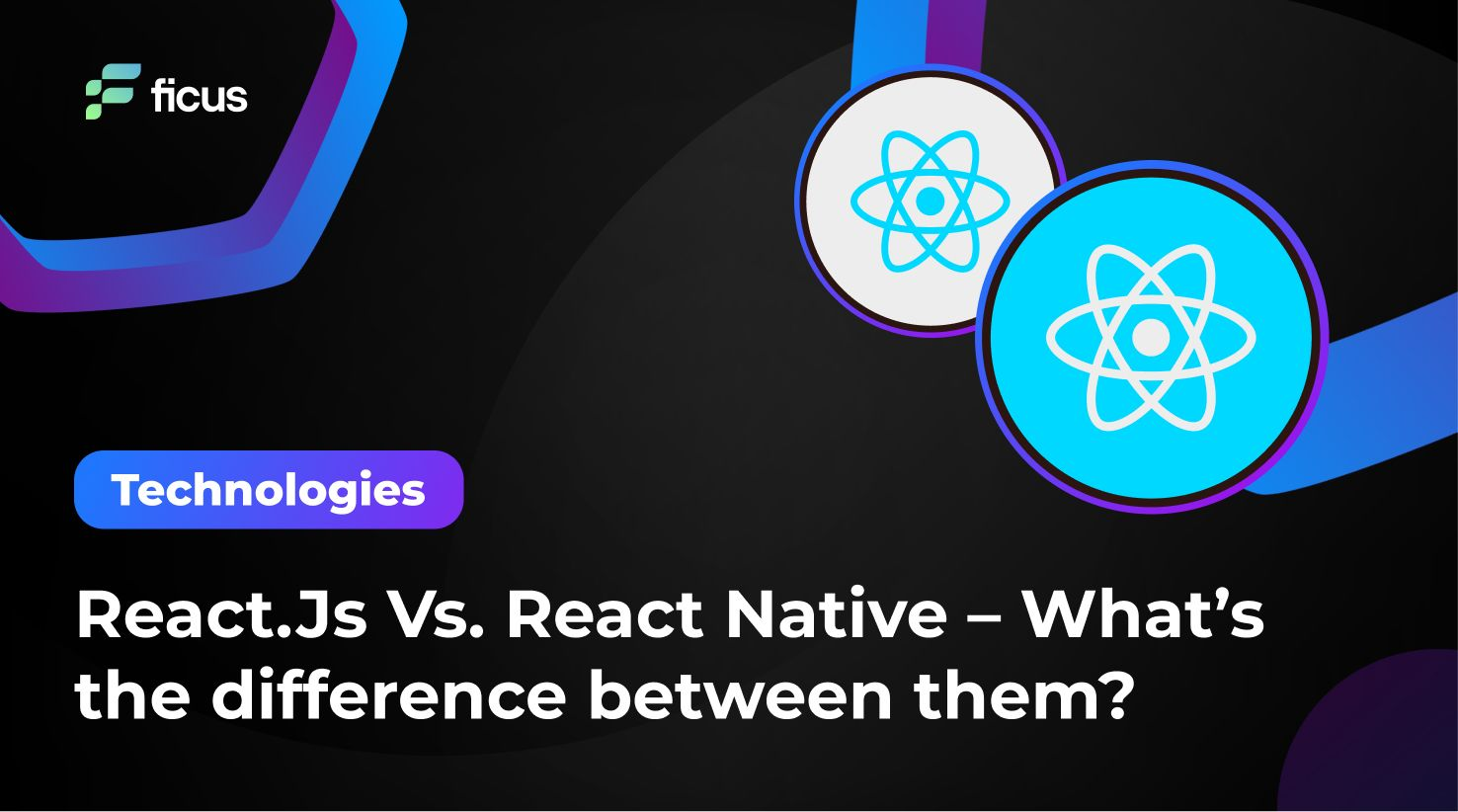We all have heard the word ‘React’ or ‘React Native,’ but only a few know what these are. Are they a framework, library, or language? Even the developers new to the IT field are not well aware of these terms and often think they are used interchangeably, but I’m afraid that’s not right. So, what are they actually, and for what purpose are they used? Let’s check out this article for a broad knowledge of these technologies.
- React.Js requires knowledge of JavaScript; React Native is based on React.Js.
- React Native allows cross-platform mobile app development, reducing code duplication.
- React.Js focuses on the front end, but React Native can also work with backend services.
React.Js vs. React Native – which one should you opt for?
What is React?
React, commonly known as React.Js, is a JavaScript library used to build user interfaces. It is used for front-end development based on User interface (UI) components and is available for free on GitHub. It was released initially on May 29 2013, by Jordan Walke, a developer on Facebook.
It is run by Facebook and other open-source developers’ communities. With React.Js, complex UI can also be made easier as it is solely responsible for the application view layer. According to a report, it is the most commonly used frontend library for Web development with smooth, dynamic, high-performing, and responsive user interfaces (UIs).

Although now it is used for backend development, that means by learning a single language, JavaScript, you may be able to develop a complete stack Web page application. React.Js is a library of JavaScript that is open source. With React.Js, Web applications can be developed far more quickly and efficiently than other frameworks like Vanilla JavaScript.
The most significant advantage of using React.Js is that it is open source, which means it has the community support of top developers worldwide. Before React.Js, creating dynamic websites comprising long pages of coding was a complex and tedious task, but now, using it requires less code with better functionality.
With the JavaScript framework – React.Js, you can quickly develop any Web application, i.e., single-page apps or static websites. In React.Js, components are reused for designing an app skeleton. Netflix redesigned its UI in 2015 through React.Js because of its many advantages. The number one was faster speed. Another example is Grammarly, a React website with millions of users worldwide and uses high-end technologies. Other examples are:
Cloudflare

Cloudflare, an American cybersecurity firm, boasts an expansive presence across the digital realm, and it proudly relies on the robust infrastructure of React.Js.
Atlassian

Atlassian, an Australian software enterprise, leverages its fundamental methodologies, employing React.Js to construct all of its singular-page software applications.
Airbnb

Airbnb, a US-based firm that rents out living spaces, also uses React to provide a more accessible communication and smooth searching experience to its users.
A recent survey unveiled a compelling statistic, revealing that in the year 2022, React.Js secured a substantial portion of 42.62% among the most prevalent web frameworks, overshadowing even the esteemed Node.Js.
Node.Js is number one based on JavaScript but is used for backend development. If you want to make your career in the Software development field, then choosing it will be a great option as it is very high in demand, and you can also step into any Web development domain. In the US, its developers can make approximately $35.33 / hour yearly, around $100k.
What is React Native?
React Native was also created by Facebook and is widely used in developing applications for Windows, Android, Android TV, iOS, macOS, tvOS, Web, etc.
It was released after the massive popularity of React.Js on March 26, 2015, but unlike React, it is used for building high-quality mobile-based applications. As its name shows it, It is based on React.Js, and it is also a JavaScript framework.
Before React Native, native mobile app development was not easy as you must use and apply different codes for different OS. For example, for Android users, you need Java developers; for iOS, Objective-C developers were required. Companies also had to decide whether they wanted to build Native mobile apps or cross-platform apps as it did not only need a reasonable budget for the development of mobile apps but also different testing codes if you want to try for all device users.
Native mobile applications are those apps that are made for specific platforms, while in cross-platform apps, the same code is used for any platform like Android, iOS, etc. Facebook solved this issue with React Native. Now, you don’t need to use different codes for different OS. With its use, you may solely depend on a single language, i.e., JavaScript, for Native and cross-platform mobile apps.

It also offers responsive user interfaces like React.Js, providing faster and cheaper features than other development technologies. It reduces the app’s load time, along with a smooth and responsive UI. You don’t need to worry about the functionality and quality of a mobile application using React Native.
Now comes its career growth; companies widely use it for mobile apps due to good deployment time and faster development. Hence, more and more job opportunities are offered, and it is a pretty good career to opt for. Due to its unique and fast performance, many top-class companies have started using it. But only a few of us know which these companies are.
In accordance with the 2019 Stack Flow Survey, X occupies the sixth position in terms of popularity among software development frameworks, a distinction that has persisted and even flourished into 2022. Remarkably, X remains the top preference for cross-platform application development. Turning our attention to remuneration, the average X developer can anticipate earning a substantial income, ranging from $75,000 to $100,000 annually, a gratifying pecuniary advantage compared to their counterparts in alternative programming languages.
Our comprehensive elucidation on the distinctions between React.Js and React Native has been presented heretofore. With this wealth of information, you are now poised to make an informed choice, whether your aspirations lean towards inaugurating your maiden web application or delving into the realm of mobile application development. However, I implore you to exercise prudent restraint before making any decisive strides. It is imperative to acquaint yourself with the nuances and operational paradigms that distinguish these two entities, a critical foundation laid out below.
React.Js vs. React Native – Key Differences?
This question often revolves around many people’s minds, like what is the difference between these top two popular frontend technologies. Both terms are popular in the information technology industry and have gained massive popularity since their release. Below, we have gathered a few main key differences, which are sufficient to give an idea about them.
- Application development: React.Js is used for building Web applications, while React Native is used for building Mobile-based applications. Initially, React Native was used only for iOS, but now it is used daily for Android and other operating systems like Microsoft.
- Built-in Library: Unlike React.Js, React Native has its built-in library for mobile app navigation and doesn’t use React Router as React.Js does for Web page navigation. As we read for single-page Web apps, React.Js is the best option, but do you know what single-page apps mean? Single-page apps refer to those apps in which content is fetched dynamically without refreshing the page, and the user can view it without moving to another page of the site.
- Installation of other tools: For developing any application using React Native, you have to download many other tools, which are Node.Js, React Native Command line interface (CLI), etc., but as React.Js is a JavaScript library, it needs a small change, i.e. integration of React library in the HTML page, you can start with your first page.
- Comprised Languages: React.Js is comprised solely of JavaScript language as it is a library of Js, so you must learn JavaScript before moving towards React.Js. On the other hand, for React Native, other languages are also included in building a full-fledged mobile application, i.e., Objective-C, Objective-C++, Java, etc., so at least a little knowledge is needed to achieve your goal of making a mobile app.
- Security: React Native comparatively offers low security as it works with the other built-in libraries that are used for UI. On the other hand, security issues are solved while using React.Js by sharing with other JavaScript frameworks.
Which is Easier: React.Js Vs. React Native?
Any person with a good knowledge of JavaScript can move towards learning its framework, React.Js. It is easy yet fascinating to create your Web apps through React.Js. For learning React Native, you must have to learn React.Js first correctly, as it is a step towards building your first mobile-based applications. Yes, you read it correctly. If you have a strong grip on React.Js, then React Native is not a challenging topic for you.
Following a good tutorial, you can have a good understanding in just a few months. However you may be able to grasp some basic React Native in a week, but for advanced concepts, you need a proper understanding of its key concepts, which cannot be acquired in a week. You need to have ample time to practice the Native applications.
They both are based on JavaScript, but React Native is widely used for building cross-platform mobile apps, which means the same code is used on different platforms i.e. iOS, Android, and Windows. Due to React Native, a mobile app can be easily run on any Operating system (OS).
Because of the debugging process, React Native is difficult as compared to React.Js. So, it means React.Js is the first step of a ladder, and it will be appropriate if you first learn the first step before diving into React Native.
Hire highly qualified developers team
Contact usReact Native vs React.Js: How do they work?
Well, now move towards their working procedure. How do they work under the hook? React.Js reuses components that make it easier for a developer to change only the needed part of the code. It means when data changes, only the right component is updated and rendered, and that’s the main reason why it has gained so much popularity in a short period.
Here (DOM) Document Object Model is used to represent the application’s User interface(UI). It is a tree structure of hypertext markup language (HTML) in an application that is mainly liable for the UI of the application. Its declarative pattern makes your application work effectively and efficiently.
React Native also uses the same approach as React.Js, meaning components are reused here. Components are small pieces of code that can be used in building an application more than once. It means the same code is used for many platforms, and hence it is a great advantage of using React Native for creating cross-platform apps.
Is React Native Backend or Frontend?
Well, this question comprises many vital concepts. As React Native is a JavaScript framework, that means it can also be used for backend development. However, its main focus is building mobile applications’ responsive front end. However, React Native top developers use it to understand the app’s API services, which are required to integrate an application.
Many backend options go perfectly with the React Native framework we have listed below: Firebase, Django, Heroku, Back4app, Backendless, Kinvey.
These all are top backend development platforms or, in other words, apps hosting services for React Native mobile apps and offer rich and excellent user experience. You can try according to the requirements of your mobile app.
Final Words
So, React.js and React Native, although they share a common JavaScript foundation and focus on creating user interfaces, serve different purposes in web and mobile application development. React.js is a great fit for front-end web development, allowing developers to efficiently create dynamic and responsive user interfaces. Its widespread use by large companies emphasizes its versatility and effectiveness in creating modern web applications. On the other hand, React Native, an extension of React.js, specializes in the development of cross-platform mobile applications, allowing you to create applications for different operating systems with the ability to reuse code. The framework has become known for simplifying the complexities associated with native mobile app development, making it a valuable tool for creating high-quality and responsive mobile apps.
At Ficus Technologies, we offer expertise in both React.js and React Native, providing end-to-end web and mobile app development solutions. Our highly skilled development team is well versed in leveraging the power of these technologies to create customized and innovative solutions. Whether you want to enhance your web presence with a dynamic user interface or start developing a cross-platform mobile application, Ficus Technologies is ready to contribute to the success of your digital projects.
React.Js is a JavaScript library primarily used for building user interfaces in web development. It is not a framework or a programming language but an open-source library maintained by Facebook and a community of developers. React.Js simplifies the process of creating interactive and dynamic user interfaces by allowing developers to build reusable UI components. It works in conjunction with JavaScript and can be integrated into web applications to efficiently manage the view layer, making it a powerful tool for building modern, responsive, and high-performance web applications.
Using vector icons in React Native involves the following steps:
Installation: Install a library like react-native-vector-icons using npm or yarn.
Linking: Link the library to your project using the command react-native link.
Import: Import the desired icon from the library in your React Native component.
Usage: Place the imported icon component in your render method, like <Icon name=”name-of-icon” size={30} color=”color” />. Customize size and color as needed.
Platform-Specific Icons: Some icons may have platform-specific names, so ensure compatibility for both iOS and Android.
Icons with Buttons: You can use icons within buttons or touchable components for interactivity.
By following these steps, you can easily incorporate vector icons into your React Native application for enhanced UI design.









The article explains in detail the main differences in terms of platform compatibility, component hierarchy, and user interface design. The author’s clarity, concise explanations, and illustrative examples make it easy for readers to understand the differences between these two powerful frameworks. This article is a valuable resource for developers learning React.Js and React Native for their projects.
I would like to thank the author for an informative article. This well-written article delves into the differences between React.js and React Native, offering valuable information for developers. The article effectively highlights the key differences in terms of platform compatibility, component reproduction, and development workflow. The author’s clear explanations and illustrative examples make it easy for readers to understand the contrasting aspects of these structures.
I applaud the author for their insightful article. This well-crafted piece serves as a valuable resource for developers seeking clarity on these two powerful frameworks. The article adeptly outlines the distinctions between React.js and React Native, shedding light on their unique features, use cases, and development approaches. The author’s clear explanations, apt examples, and concise comparisons make it easy for readers to grasp the key differences.